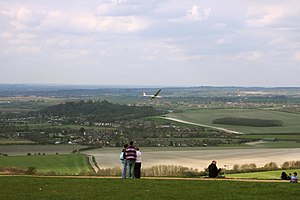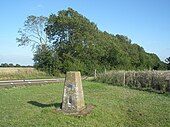Dunstable Downs: Difference between revisions
No edit summary |
|||
| Line 7: | Line 7: | ||
|range=Chilterns | |range=Chilterns | ||
|os grid ref=TL008194 | |os grid ref=TL008194 | ||
|latitude=51.8640 | |||
|longitude=-0.5375 | |||
}} | }} | ||
The '''Dunstable Downs''' in southern [[Bedfordshire]] are part of the [[Chiltern Hills]]. They are a chalk escarpment forming the north-eastern reaches of the Chilterns. | The '''Dunstable Downs''' in southern [[Bedfordshire]] are part of the [[Chiltern Hills]]. They are a chalk escarpment forming the north-eastern reaches of the Chilterns. | ||
At 797 | At 797 feet, the Dunstable Downs are the [[County top|highest point of the county]] of Bedford. It lies close to the county tops of Hertfordshire and Buckinghamshire also, at [[Pavis Wood]] and [[Haddington Hill]] respectively. | ||
Because of its elevation, Dunstable Downs hosted a station in the shutter telegraph chain which connected the Admiralty in London to its naval ships in the port of [[Great Yarmouth]] during the years 1808 to 1814.<ref>{{cite web | publisher=''Great Yarmouth Mercury'' | url=http://www.greatyarmouthmercury.co.uk/content/yarmouthmercury/content/porthole/story.aspx?brand=GYMOnline&category=Porthole&tBrand=GYMonline&tCategory=porthole&itemid=NOED03%20Jan%202008%2015%3A17%3A31%3A957 | title=Shutter telegraph signalled new era | accessdate=2008-02-23}}</ref> | Because of its elevation, Dunstable Downs hosted a station in the shutter telegraph chain which connected the Admiralty in London to its naval ships in the port of [[Great Yarmouth]] during the years 1808 to 1814.<ref>{{cite web | publisher=''Great Yarmouth Mercury'' | url=http://www.greatyarmouthmercury.co.uk/content/yarmouthmercury/content/porthole/story.aspx?brand=GYMOnline&category=Porthole&tBrand=GYMonline&tCategory=porthole&itemid=NOED03%20Jan%202008%2015%3A17%3A31%3A957 | title=Shutter telegraph signalled new era | accessdate=2008-02-23}}</ref> | ||
Latest revision as of 17:08, 21 March 2018
| Dunstable Downs | |||
| Bedfordshire | |||
|---|---|---|---|
 Dunstable Downs | |||
| Range: | Chilterns | ||
| Summit: | 797 feet TL008194 51°51’50"N, -0°32’15"W | ||
The Dunstable Downs in southern Bedfordshire are part of the Chiltern Hills. They are a chalk escarpment forming the north-eastern reaches of the Chilterns.
At 797 feet, the Dunstable Downs are the highest point of the county of Bedford. It lies close to the county tops of Hertfordshire and Buckinghamshire also, at Pavis Wood and Haddington Hill respectively.
Because of its elevation, Dunstable Downs hosted a station in the shutter telegraph chain which connected the Admiralty in London to its naval ships in the port of Great Yarmouth during the years 1808 to 1814.[1]
Nearby Whipsnade Zoo has cut an enormous lion shape into the chalk into the side of one of the hills. The lion can be seen from the B489 (Aylesbury to Dunstable road).
Activities on the downs
The downs are used by gliders, kite fliers, hang gliders and paragliders in the area because of their height. The London Gliding Club is based at the foot of the downs.
Much of the downs is managed by the National Trust as part of its "Dunstable Downs, Countryside Centre & Whipsnade Estate" property.
Ascents

The summit is not a challenge by car: the B4541 road crosses the hill and the summit, marked by a trig point, is next to the road.
For those who wish to climb the hill from the base, it is possible to do a circular walk from the village of Whipsnade by following the Icknield Way Path and Chiltern Way, both of which are marked on Ordnance Survey maps. This circuit can be extended to take in the northern top of Five Knolls. The hill can also be ascended from Dunstable to the north. The Icknield Way Trail[2], a horse rider and off-road cycle route, has been established following a similar route to the Icknield Way Path which passes over the Dunstable Downs.
It is a beautiful view from the top of an almost unspoilt hill, just the road and the small trig point intruding, or at least it was until the local council and the National Trust conspired to build big a glass-and-steel visitor centre ("The Chilterns Gateway Centre", right on the very top of Dunstable Downs, presumably not out of malice but out of public funds.
Birds, beasts and blooms

The downs are home to a wide variety of wildlife including many rare wild flowers, such as the Bee Orchid, and different butterfly species, like the Marbled White and the Chalkhill Blue.
Areas of the west-facing slope were notified in 1987 under the Wildlife and Countryside Act 1981 as a Site of Special Scientific Interest called Dunstable and Whipsnade Downs. This includes parts of Whipsnade Zoo.[3]
Blow's Downs
Blow's Downs or Blow's Down are a continuation of the Dunstable Downs escarpment on the eastern side of Dunstable.
The area is designated a Site of Special Scientific Interest,[4] most of which is managed as a nature reserve by the Wildlife Trust for Bedfordshire, Cambridgeshire, Northamptonshire and Peterborough.[5]
Outside links
- Dunstable Downs, Countryside Centre & Whipsnade Estate at the National Trust
- Blow's Downs - Wildlife Trust for Bedfordshire, Cambridgeshire, Northamptonshire and Peterborough
- London Gliding Club
Notes and references
- ↑ "Shutter telegraph signalled new era". Great Yarmouth Mercury. http://www.greatyarmouthmercury.co.uk/content/yarmouthmercury/content/porthole/story.aspx?brand=GYMOnline&category=Porthole&tBrand=GYMonline&tCategory=porthole&itemid=NOED03%20Jan%202008%2015%3A17%3A31%3A957. Retrieved 2008-02-23.
- ↑ Icknield Way Trail.
- ↑ "Dunstable and Whipsnade Downs". English Nature. http://www.english-nature.org.uk/citation/citation_photo/1004427.pdf. Retrieved 2008-02-23.
- ↑ Natural England, Blow's Down.
- ↑ Blow's Downs - Wildlife Trust